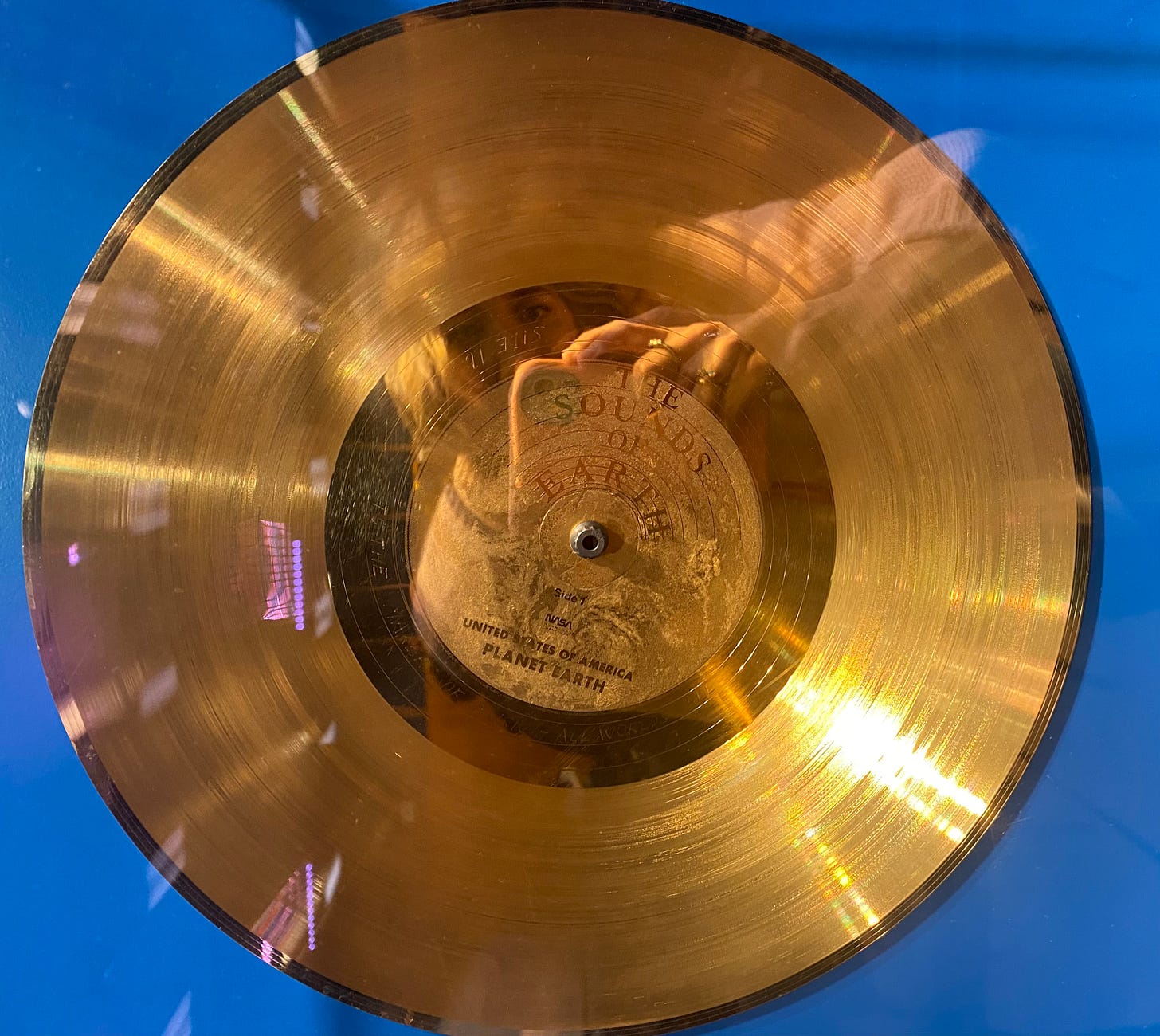Last week, I was lucky enough to take a tour at JPL (NASA’S Jet Propulsion Laboratory), where scientists and engineers imagine and build the robots, rovers, probes, and satellites that NASA sends into space. I saw rocks ~they~ brought back from the moon, life-sized copies of various satellites and rovers that have been to Mars, and even a copy of the Golden Record, a disc whose very existence illustrates that bombastic earnestness, pride, and optimism of the human race.
I was first introduced to the Golden Record in Jenny Offill’s Dept. of Speculation (a non-negotiable must-read -!), and the very notion of it has warmed my human heart ever since. In 1977, two gold-plated copper phonograph records were sent on the Voyager spacecrafts, which have long since passed Pluto and are now floating way, wayyyyyy out in interstellar space. Each phonograph is imprinted with the “Sounds of Earth” and instructions for how to play them. There are sounds such as thunder, volcanoes, mudpots, whale songs, and songs that humans have made, from Beethoven to Blind Willie Johnson, a Peruvian wedding song, a Navajo night chant. Sounds of the first tools, a mother kissing a child, chimpanzees, footsteps, and laughter. Imprinted images of the human anatomy, DNA material, a sperm implanting an egg, a fetus in utero, a doctor pulling a baby upside down out of a woman, a woman nursing an infant, snowflakes over the Sequoias, a Balinese dancer, a Thai woodworker. An astonishing, reverential collection of humanity. A snorkeler, fish on the grill, a dinner party. A sanguine assemblage revealing the fundamentals of life on Earth, of what the planet gives and what we take and make from it.
Carl and Linda Sagan were tasked with this record, for which they collected greetings in 55 different languages to whomever finds the record.
The greetings are an aural Gestalt, in which each culture is a contributing voice in the choir. After all, by sending a spaceship out of our solar system, we are making an effort to de-provincialize, to rise above our nationalistic interests and join a commonwealth of space-faring societies, if one exists." -Linda Sagan
The recorders were given a small set of parameters for what to say - a simple, short greeting, in their native language, to whomever might discover this record in space. The recorded salutations are almost overwhelming to read, all at once - so heartfelt, so hopeful, so welcoming, it seems impossible to believe the daily blight of horrific behavior humans are equally responsible for every moment of every day on this planet.
Here are a few of these greetings, best read while listening to this:
Amoy (Min dialect)
"Friends of space, how are you all? Have you eaten yet? Come visit us if you have time."Arabic
"Greetings to our friends in the stars. We wish that we will meet you someday."Burmese
"Are you well."Czech
"Dear Friends, we wish you the best."English
"Hello from the children of planet Earth."Greek
"Greetings to you, whoever you are. We come in friendship to those who are friends."Hittite
"Hail."Indonesian
"Good night ladies and gentlemen. Goodbye and see you next time."Mandarin Chinese
"Hope everyone's well. We are thinking about you all. Please come here to visit when you have time."Persian
"Hello to the residents of far skies."Polish
"Welcome, creatures from beyond the outer world."Rajasthani
"Hello to everyone. We are happy here and you be happy there."Swedish
"Greetings from a computer programmer in the little university town of Ithaca on the planet Earth"Thai
"We in this world send you our good will"Turkish
"Dear Turkish-speaking friends, may the honors of the morning be upon your heads."Ukrainian
"We are sending greetings from our world, wishing you happiness, goodness, good health and many years."
It’s hard to pick a favorite, but I especially love how the Mandarin greeting reads like a postcard from a grandma on holiday at the summer lake cabin.
I am reminded of the Eduardo Galeano quote excerpted at the end of Almodovar’s Parallel Mothers:
“No history is mute…Human history refuses to shut its mouth.”
Later in the tour, we observed engineers working on the Europea Clipper, a spacecraft that will head to Jupiter’s moon, Europa, which has apparently shown strong evidence of harboring life beneath its icy crust. It will leave in 2024 and will arrive in 2030. 6 long years to travel all the way to Jupiter’s orbit. Rowan will be 13 years old by then, Zoe will be 11. We will watch on some invisible screen no doubt projected into the ether of our living room (all my ideas about future technology are still firmly-rooted in a single viewing of Minority Report), as the Clipper reaches its final destination, searching for proof that all these lives out here will, must someday add to the stories of someone or something very real and pulsating and multiplying out there.
And I will be reminded of the time, 7 years prior, when I stood above that very spacecraft, and a scientist in a white hazmat suit looked up and beheld the dumbstruck plebeians taking it all in behind a huge glass wall, and reached out his hand to play “Rock, Paper, Scissors” with whomever was eager enough to reply quickly enough. He counted down from 3, his fingers encased in rubber gloves, and lost the third round as One of Us covered his (moon) rock with paper — a salient win in honor of the written story that will inevitably follow his quest out to the cosmos.






this was my favorite saying: "Hello to everyone. We are happy here and you be happy there." love the implication of it.